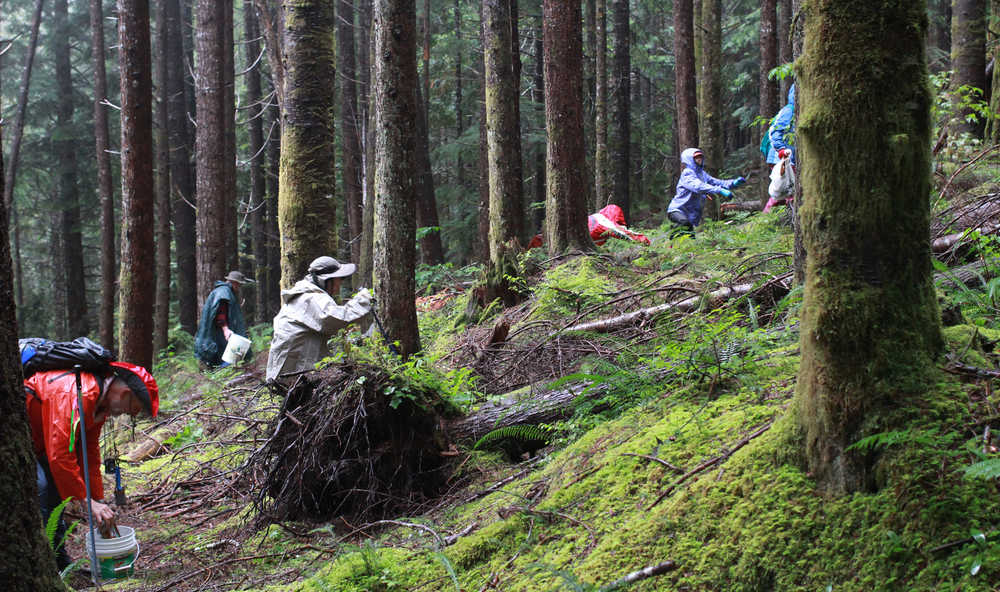SKYKOMISH, Wash. (AP) — The rain is falling without mercy. It’s midmorning, but a gray blanket of low clouds tucks the forest in so cozily that it might as well be dusk. Even with Gore-Tex wrapping, moisture seems hell-bent on coating every square inch of skin.
Ah, the pleasure of fall in the mountains of the Northwest. The finicky season leaves us ruing the end of comfortable backpacking and dreaming of ski tips plowing gracefully through powder.
But what to do while we wait?
For those of us who typically seek high alpine views, it’s time to set your sights lower, even below the salal and sword ferns on the forest floor, to where fungi fruit plentifully.
The allure of foraged mushrooms brought 12 of us tromping across national forest land near Skykomish, happily braving the rain, dodging moss-laden trees and scrambling up steep embankments.
“It’s like an adult Easter egg hunt,” said Wren Hudgins, a volunteer with the Puget Sound Mycological Society (PSMS), who was leading the group of newbie hunters during the organization’s fall field trip.
Most Easter egg hunts don’t require the whistles that Hudgins asked we carry, though. It’s surprisingly easy to focus so intently on the hunt that you lose track of your surroundings.
“Mushroomers are really vulnerable to get lost. They’re looking down, walking off trail and walking in circles,” Hudgins said.
Eyes out for the prize
The group fans out, each member’s eyes sweeping the undergrowth for a variety of fungi. Mostly, they hope to catch a glint of golden chanterelle mushrooms, which are an attainable prize for a beginning hunter.
Smelling of apricot, the chanterelle is a stout, fleshy mushroom with a mild nutty flavor. In stores and when in season, the mushrooms typically fetch north of $10 a pound. They add savor and substance to risotto and play nicely with eggs.
Chanterelles and other wild edibles like Boletus edulis (porcinis) are so prized that many experienced hunters keep their searching grounds a secret.
“You’ll ask people where they found those boletes or chanterelles, and they’ll say, ‘Oh, east of here,’ or ‘Up in the woods,’ “ Hudgins said. Some people park a quarter-mile from where they hunt, to keep the competition guessing, he added.
For that reason, and because consuming a misidentified mushroom can send you to the hospital or worse, it’s best to tag along with an expert like Hudgins on a first trip.
Hudgins, who has been part of the mushroom society on and off since 1974, calls foraging “kind of a geeky hobby.”
A psychologist by trade, he said there isn’t a certain type of person drawn to the fungi search. Curiosity is the only thing that binds foragers, he said.
And that runs the gamut.
Shannon Adams, the club’s media coordinator, said many are interested in foraging and gastronomy, while others seek mushrooms for the colors they produce to dye fabric. Some, like her, keep a sketchbook or paint mushrooms. Others seek to identify rare species. Hikers often join the group to educate themselves should they get lost in the backcountry.
Then there are those looking for a mentally transformative experience. (“We don’t encourage that in the club, but it’s there,” Adams said, of some foragers’ interest in hallucinogenics.)
Michael and Natasha De Plater, who moved to Capitol Hill a few years ago from Australia, brought their 9-year-old daughter, Frankie, on the group hunt. The De Platers were curious about the wild fungi they had seen while hiking.
Frankie proved to be an energetic searcher.
“Kids are often the best mushroom finders. They have a short angle. They’re looking under the sword ferns we look on top of,” Hudgins said.
The family found one chanterelle, and a pile of other colorful species to bring back for expert eyes.
Down-to-earth expert
Back at base camp, PSMS identification chair Brian Luther examined the De Platers’ haul, smelled the mushrooms and even took a nibble of one species (don’t try this yourself; he’s an expert).
As if to embody the role of a folksy mycological raconteur, Luther sported red suspenders, a mustache and a toadstool button pinned on his shirt.
He announced each mushroom’s Latin name, told origin stories (the lobster mushroom is actually two fungi, one of which is a parasite, we learned), and placed each find on his edibility continuum, a scale from “choice” to “worthless.”
“Ooh. smell this,” Luther often exclaimed, before offering a sniff of a mushroom that carried the distinct aroma of radishes or lemon peel.
Luther provides a security blanket as much as showmanship. He pointed out a few mushrooms that “will make you absolutely, violently sick,” which ought to warn anyone off hunting without an expert.
Even chanterelles, which are relatively easy to identify, have a handful of poisonous lookalikes.
Once through hunting, some in the group warmed themselves by the fire and told mushroom stories. One man regaled the assembly with a tale about the time he flipped over his handlebars and landed in a field of glorious chanterelles.
Others brushed away the dirt from their precious finds.
Laura Callow, a teacher, was planning a meal for every mushroom found, including a cream sauce with thyme. She’d purchased chanterelle and lobster mushrooms before, but never found her own or cooked with such sizable specimens, she said.
Architect Jessie McClurg was thrilled to have found several pounds of chanterelles, angel wings and shrimp russula. A trail runner and hiker, she said foraging for fungi shifted her perspective about the forest.
“When you’re trail running, you’re focusing on the views and vistas. With this, you’re focusing on a different scale in the same environment.”

